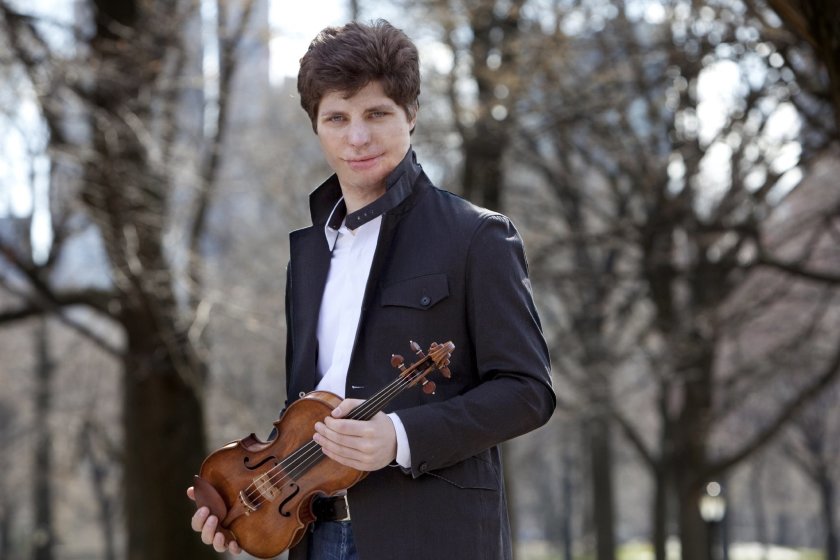Hadelich does double duty with Houston Symphony from Bach to blues

The Houston Symphony dispensed with a conductor Friday night. Violinist Augustin Hadelich did double duty at Jones Hall, leading the orchestra—reduced to about two dozen players—in a program that tested everyone’s skills as stylistic quick-change artists.
Hadelich and the orchestra went straight from buoyant J.S. Bach to Dmitri Shostakovich’s brooding and ferocity. With no intermission to let the musicians catch their breath, Hadelich immediately dashed off a bit more Bach. Then everyone turned to the rococo brightness of a concerto by Mozart’s contemporary Joseph Boulogne, Chevalier de Saint Georges.
By and large, Shostakovich’s trademark intensity came across as readily as Bach’s and Boulogne’s vigor. And the night was a tour de force for Hadelich: he may not have handled the leadership role as visibly as some instrumentalists do, but he played commandingly and colorfully for 80 minutes virtually nonstop.
In Bach’s Concerto in C minor for Violin and Oboe, Hadelich and Jonathan Fischer—the Houston Symphony’s principal oboist—dispatched the solo parts with fluency and finesse. Hadelich’s silvery tone complemented the fuller sound Fischer gave the oboe part, and both shaped Bach’s lines with a deftness that turned streams of notes into lively phrases.
TheAdagio unfolded at a flowing pace that let Hadelich and Fischer savor the lilt and shapeliness of Bach’s long melody; the music almost took on the tenderness of a lullaby. In the finale, where the violin part sometimes practically runs in circles around the oboe, Hadelich zipped clearly through even the speediest turns.
With minimal overt direction from Hadelich and concertmaster Yoonshin Song, the orchestra brought Bach transparency and zest. The bulk of Hadelich’s leadership clearly came during rehearsals with no need for redundant stage theatrics.
Shostakovich’s Violin Sonata dates from the anguished composer’s last years. On Friday night, the half-hour work was performed in the arrangement by Andrei Pushkarev and Mikhail Zinman for Violin, Percussion and String Orchestra.
This version loses the piano’s sonic contrast with the violin, not to mention the bite and explosiveness that a powerful pianist can inject in the fierce second movement. On the plus side, the strings’ sustaining power brings a new tension to Shostakovich’s long-breathed themes, and the lower strings’ depth and resonance make some of their key moments especially arresting.
On Friday, the sheer range of Hadelich’s sound gave the sonata an epic scale. His muted tone lent the opening theme an air of smoldering tension, and as the intensity built, so did the heft. The violinist’s fiery tone harkened back to his blockbuster performance of Jean Sibelius’ Violin Concerto with the orchestra in 2018. Yet the little dance tune, in Hadelich’s hands, moved with a gentle spring in its step. That made its wryness all the more haunting.
When the second movement’s aggression burst out, Hadelich’s agility and abandon unleashed its force without his resorting to mere slashing. As he introduced the finale’s passacaglia theme, the sharp snap of his pizzicatos exerted still another kind of stark power.
As the variations unfolded, his kaleidoscopic shifts of color helped create an arresting series of moods and atmospheres, and Hadelich gave the music a few, fleeting moments of lyrical expansiveness. The disembodied sound of the violin’s last tremolos ended the sonata with a sonic shiver. The orchestra also treated Shostakovich to a big sonic range, from ghostly pizzicatos to snarling chords, and complemented Hadelich’s drama and impact.
Perhaps to return everyone to the light of day, so to speak, after the sonata’s shadowy ending, Hadelich swept through the well-known Prelude from Bach’s Partita in E major, bringing it nimbleness and finesse galore. The brightness continued into Boulogne’s Violin Concerto in A major, Op. 5, No. 2.
The son of a French plantation owner and a slave, Boulogne is one of the long-neglected composers enjoying new attention thanks to U.S. orchestras’ recent focus on composers from diverse backgrounds. Even though he was a contemporary of Mozart, his music looks back—at least in this concerto—to the rococo era’s crispness and clarity. The themes are brisk and concise; the slow movement’s sweetness encounters no emotional crosscurrents.
Hadelich and the orchestra showcased the music’s attractions through the gleam, tautness and clarity of their playing. Then the tireless violinist capped off the night—and added another bit of diversity—with Coleridge-Taylor Perkinson’s Louisiana Blues Strut. As he cut loose with the music’s freewheeling slides and syncopations, he put Shostakovich’s anxieties far into the past.
As of this season, Houston Symphony concerts are benefiting from acoustical work done at Jones Hall over the summer. Inserts into the side walls have a slightly different angle relative to the stage, reflecting the sound more clearly to the audience, executive director John Mangum explained. Also, openings high in the side walls let the sound reverberate in spaces on the other side. The difference was especially evident last Sunday in Beethoven’s Triple Concerto and Symphony No. 5, which rang out with an immediacy and impact new to Jones Hall.
The program will be repeated 8 p.m. Saturday and 2:30 p.m. Sunday. houstonsymphony.org